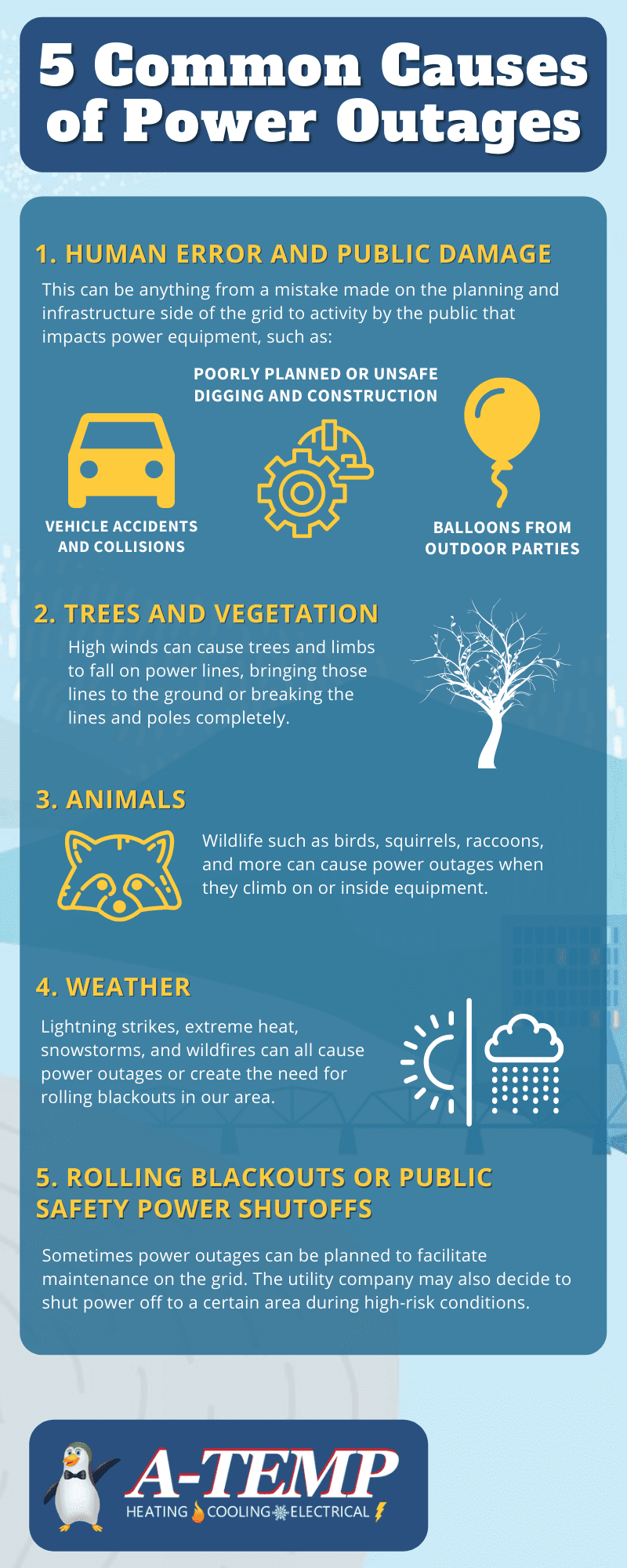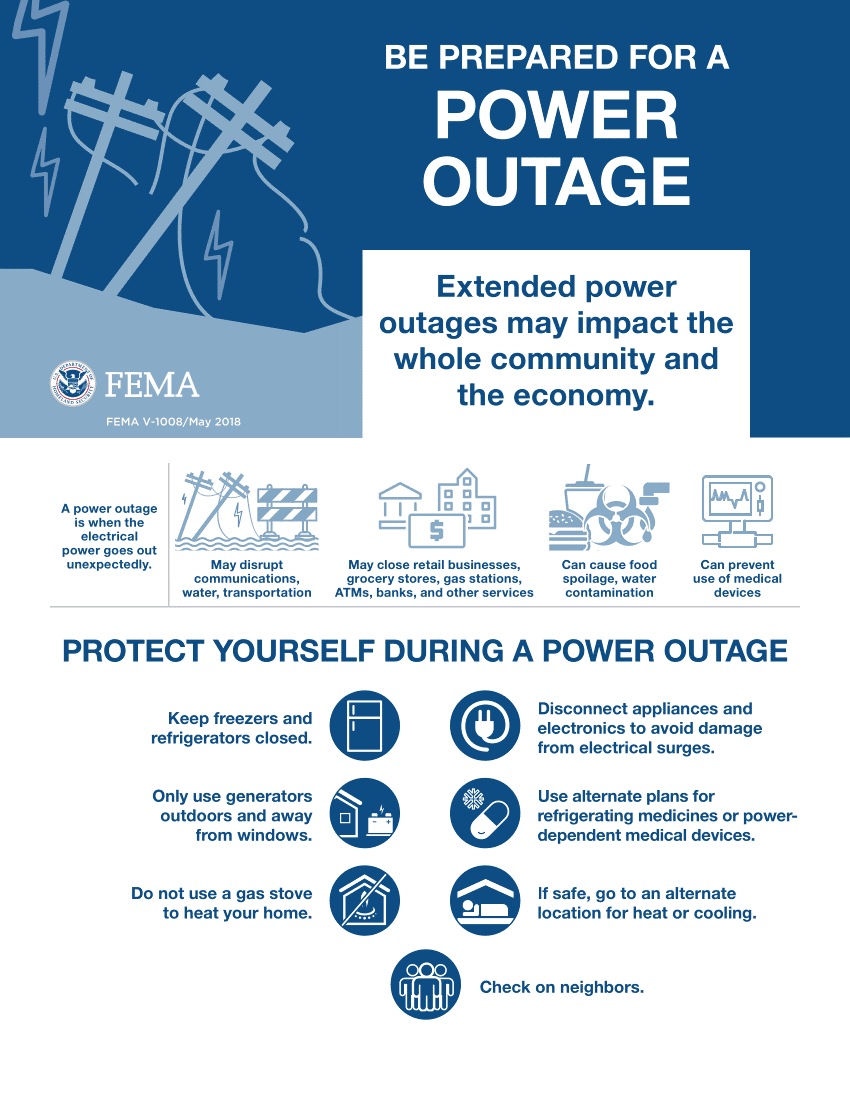Other Hazards
Power Outage Causes
Power outages can be caused by extreme weather or any event that damages the utility’s infrastructure. Some common causes of power outages are:
-
- Windstorms
- Winter Storms
- Wildfires
- Extreme heat
- Drought
- Animal/Wildlife interference
- Car collision
- and many others!
In addition to power outages caused by damage or disruption to utility infrastructure, there is also a potential for a Public Safety Power Shutoff (PSPS). Public Safety Power Shutoffs are a safety measure issued by the electric utility service provider to protect communities at high risk for wildfire by proactively shutting off electricity during extremely hot and dry periods, since it can cause the electric system to spark wildfires. Your electricity provider should inform you ahead of time if a PSPS is issued. Click here for more information about Public Safety Power Shutoffs.
Preparing for a Power Outage
Tips to Prepare for a Power Outage:
-
- Take inventory of the items you need and use daily that rely on power (such as lighting, heating/AC, refrigerator, electricity-dependent medical devices, cell phones, etc.) and identify an alternative power source, such as a power bank, portable charger, generator, or batteries.
- Invest in alternative power source(s) like the ones listed above. Practice using them, especially generators, and make sure power banks and portable chargers are fully charged.
-
- If relying on a generator as your alternative source of power, please only operate the generator outdoors and away from windows. The Red Cross’s Safe Generator Use page has tips on how to determine the right size generator for your needs, as well as safety and usage tips.
-
- Prepare an emergency kit with enough food, water, medicine, and other essential supplies to support your household, including pets and livestock, for 2 weeks.
-
- Power outages are most common in the summer and winter months, but the challenges presented by power outages are very different for these two seasons. For a summer power outage, consider adding hand held or battery powered fans and other cooling devices to your emergency kit. For a winter power outage, make sure you have plenty of warm clothes and layers, as well as matches, candles, heating packs and other warming mechanisms.
- Make sure the majority of your emergency food supply is non-perishable foods.
- Have one flashlight or light source per family member.
-
- Know what perishable foods are safe to keep/eat and what needs to be thrown out based on the temperature and duration of the power outage.
-
- Click here to view the Food During a Power Outage Safety Charts.
-
-
- Make sure you are registered to receive alerts through your local alert system.
-
- Locally that is LaneAlerts.
- Also make sure your contact information for your utility company is up to date.
-
- If you rely on an electricity-dependent medical device or refrigerated medicine, talk to your doctors and care providers about a care continuity plan. Additionally, reach out to your utility company and ask to register for a Medical Certificate. People with registered Medical Certificates will likely get the first warning about a potential power outage or PSPS. Learn more about the Oregon Medical Certificate Program here.
- Keep cell phones and other important devices fully charged and fill up on gas for your car.
- Know how to reset your circuit breakers.
- Know where the closest emergency warming and/or cooling shelters are to where you live and how to contact them.
- Make sure you are registered to receive alerts through your local alert system.
During and After a Power Outage
During a Power Outage:
-
- Unplug all appliances and electronics to prevent damage from electrical surges.
-
- Excpet for the refrigerator and freezer.
-
- Contact your utility provider to alert them of the power outage.
- Eat your perishable foods before your nonperishables to help elongate your food supply.
- Stay warm or cool however you can, and seek shelter for warming/cooling if needed.
- Avoid downed power lines!
- Unplug all appliances and electronics to prevent damage from electrical surges.
After a Power Outage:
-
- Throw away any food that has been in temperatures over 40 degrees for 2+ hours. When in doubt, throw it out!
-
- Click here to view the Food During a Power Outage Safety Charts.
-
- Throw away any food that has been in temperatures over 40 degrees for 2+ hours. When in doubt, throw it out!
-
- Discard any medication that needs to be refrigerated after 24 hours, unless the label says otherwise. Consult your provider or pharmacist if you have any questions or concerns.
Further Information about Power Outages and Outage Preparedness
-
- https://www.ready.gov/power-outages
- https://portlandgeneral.com/outages-safety/be-prepared/prepare-your-home
- https://www.oregon.gov/puc/safety/pages/power-outage-prep.aspx
- https://www.almanac.com/power-outages-what-do-during-and-after-outage
- https://www.redcross.org/get-help/how-to-prepare-for-emergencies/types-of-emergencies/power-outage.html




